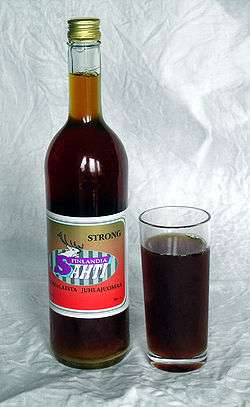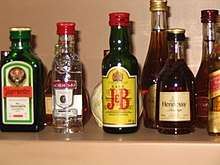Sahti

Sahti is a Finnish beer made from malted and unmalted grains including barley, rye and oats. Traditionally the beer is flavored with juniper in addition to, or instead of, hops;[1] the mash is filtered through juniper twigs into a trough-shaped tun, called a kuurna in Finnish. Sahti is top-fermented and many have a banana flavor due to isoamyl acetate from the use of baking yeast, although ale yeast may also be used in fermenting.
The end product is a cloudy beer phenolic flavors and a distinct taste similar to banana, balanced by the bitterness from the juniper branches. The carbonation level tends to be very low. Sahti was traditionally brewed as a farmhouse ale,[2] but commercial versions are now available. Commercial sahti is usually 8% ABV. In Finland, due to the higher percentage of alcohol in sahti, it is only sold in commercial sahti breweries, pubs or state-owned Alko stores, not in regular markets or grocery stores. Sahti has to be stored cold until consumption and is therefore not available in all Alko branches.
The etymology of the word sahti is not certain. It possibly stems from the Germanic saf, which later evolved into the Scandinavian saft, meaning "juice."
Finnish Sahti
Within Finland, sahti has differing characteristics depending on which part of the country it is from. It is often known as Tavastian beer from Häme (well-known sahti areas, such as Sysmä, Joutsa, Kuhmoinen and Lammi, are in Häme) but it is also made in Finland Proper and some parts of Central Finland. A farmhouse ale that in some cases is similar is brewed on the Swedish island of Gotland (known as Gotlandsdricka). An even closer relative in terms of flavour is a farmhouse ale known as "Koduõlu" or "Taluõlu", brewed on the Estonian islands in the Baltic. Every year the Finnish sahti brewing championship is held on the first weekend in August[3].
Sahti in other countries
Finnish sahti has Protected Geographical Status in Europe.[4] In the United States, sahti has been the subject of recent interest by homebrewers and microbreweries; in 2008, Dogfish Head Brewery released a beer called Sah'tea, a collaboration with Finnish brewer Juha Ikonen, that was supposedly a hybrid of traditional Sahti and Chai tea.[5] New Belgium Brewing Company of Colorado is now also brewing a beer they describe as sahti.[6] Samuel Adams also claims to brew a Sahti called "Norse Legend", and Off Color Brewing from Chicago has recently begun producing a sahti called "Bare Bear". Parallel 49 in Vancouver, BC released their "Sahti Claus" for Winter 2013. The Elysian Brewing Co. in Seattle, WA has produced a Sahti-style beer with an addition of pumpkin named "Kurpitsahti" or pumpkin sahti, for their Great Pumpkin Beer Festival.
Modern craft beer versions of sahti can be somewhat removed from the original style, because brewers may use more hops, might not use juniper twigs, could introduce more carbonation, boil the wort, and may not use Finnish baking yeast.
Brewing process
Traditionally, the most common sahti brewing process is using a long step infusion mash that may last up to six hours, after which the wort is lautered through the kuurna. Unlike most beers, traditional sahti wort goes straight from the lauter tun to the fermenter without boiling. This increases the chances of infection by lactic bacteria somewhat, and the very low usage of hops also tends to make it keep poorly.
However, this is only one of several brewing processes that have traditionally been used. Sahti has also been brewed as a stone beer, with infusion mashing, with variants of decoction mashing, by boiling the mash in the kettle, and so on. Some regions of Finland have called their farmhouse ale taari, and in these areas different brewing processes appear to have been used, such as fermenting in the mash, and baking the wet malts in bread-like shapes before lautering.[2]
Commercial Sahti brands
- Panimoravintola Beer Hunter's: Mufloni Sahti (from Pori)
- Finlandia Sahti and Finlandia Strong Sahti (from Sastamala)
- Hartolan Sahti, known as Krouvin Sahti and Punakallion Sahti.
- Hollolan Hirvi Kivisahti
- Huvila sahti (from Savonlinna)
- Joutsan Sahti
- Lammin Sahti (from Lammi)
- Tiinan Sahti (from Sysmä)
- Stadin Panimo: Stadin Sahti (from Helsinki)
See Also
- https://en.m.wikipedia.org/w/index.php?title=Finnish_cuisine&action=edit§ion=9
Non-Finnish Commercial Sahti brands
As the term 'Finnish Sahti' has protected geographical status, technically these companies must simply call their beverage Sahti or Finnish-Style Sahti. It is not clear if any of them actually resemble the original Finnish sahti beers.
- Mad Scientist #19 from Sixpoint Brewing
- Samuel Adams: Norse Legend sahti (from Boston, Massachusetts, U.S.A.)
- Dogfish Head Brewery: Sah'tea (from Milton, Delaware, U.S.A.) made with masala chai and juniper berries
- Sahti Ale - New Belgium Brewing Company (from Fort Collins, Colorado, U.S.A.)
- Parallel 49 Brewing Company "Sahti Claws"
- Sahti - Gambling Man Brewing Company, UK (The first true Sahti to be commercially brewed in the UK)[7]
- Ale Apothecary - "Sahati," a mixed fermentation ale lautered in a spruce kuurna with spruce branches
- Browar Pinta - "Koniec Świata" (pol. "The End of The World, owes its name to the date of its release to the market, which was supposed to be the end of the world), polish attempt of brewing Sahti beer. Made with juniper berries and branches.
- Bare Bear from Off Color Brewing
- Kurpitsahti (Pumpkin Sahti) from Elysian Brewing Co.
In Estonia one commercial beer is sometimes described as "Estonian sahti", despite actually being an Estonian koduõlu:
- Pihtla Õlu from Pihtla õlleköök, Estonia
References
- ↑ Peter Ovell, "Finland's Indigenous Beer Culture." Perinteisen Oluen Seura, Special Publications No 1, 1996. Helsinki. (accessed 2017-11-21)
- 1 2 Matti Räsänen, "Vom Halm zum Faß." Kansatieteellinen arkisto, Helsinki, 1975. ISBN 9519056181.
- ↑ http://www.sahti.org/smkilpailu.htm
- ↑ EU Profile-Sahti (accessed 07/06/2009)
- ↑ Burkhard Bilger, "A Better Brew." The New Yorker. November 24, 2008 (accessed 01/27/09)
- ↑ "Sahti Ale - New Belgium Brewing". newbelgium.com.
- ↑ http://www.cannybevvy.com/blog/2014/04/14/gambling-man-brewery-sahti-beer/


